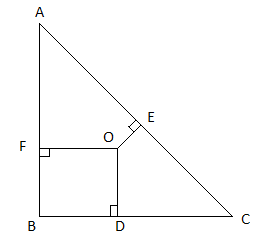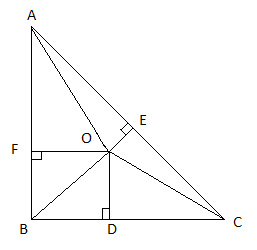
In fig, \[O\] is a point in the interior of a triangle \[\Delta ABC\], \[OD \bot BC,OE \bot AC\] and \[OF \bot AB\]. Show that,
1. \[O{A^2} + O{B^2} + O{C^2} - O{D^2} - O{E^2} - O{F^2} = A{F^2} + B{D^2} + C{E^2}\]
2. \[A{F^2} + B{D^2} + C{E^2} = A{E^2} + C{D^2} + B{F^2}\]


Answer
574.5k+ views
Hint: At first, we need a construction.
By the given condition and Pythagoras theorem we can prove the required proof.
Pythagoras theorem states that, for a right-angle triangle, the value of the square of the hypotenuse is the sum of the square of base and the square of perpendicular.
\[{\text{Hypotenus}}{{\text{e}}^{\text{2}}}{\text{ = bas}}{{\text{e}}^{\text{2}}}{\text{ + perpendicula}}{{\text{r}}^{\text{2}}}\]
Then, we will add or subtract the conditions as per the need.
Complete step-by-step answer:
It is given that; \[O\] is a point in the interior of a triangle \[\Delta ABC\], \[OD \bot BC,OE \bot AC\] and \[OF \bot AB\].
We have to show that,
1. \[O{A^2} + O{B^2} + O{C^2} - O{D^2} - O{E^2} - O{F^2} = A{F^2} + B{D^2} + C{E^2}\]
2. \[A{F^2} + B{D^2} + C{E^2} = A{E^2} + C{D^2} + B{F^2}\]
Pythagoras theorem states that, for a right-angle triangle, the value of the square of the hypotenuse is the sum of the square of base and the square of perpendicular.
That means,
\[{\text{Hypotenus}}{{\text{e}}^{\text{2}}}{\text{ = bas}}{{\text{e}}^{\text{2}}}{\text{ + perpendicula}}{{\text{r}}^{\text{2}}}\]
Let us join \[O,A;O,B;O,C\].

From the \[\Delta AOE\],
Using Pythagoras theorem, we get,
\[A{O^2} = A{E^2} + O{E^2}\]… (1)
From the \[\Delta AOF\],
Using Pythagoras theorem, we get,
\[A{O^2} = A{F^2} + O{F^2}\]… (2)
From the \[\Delta FBO\],
Using Pythagoras theorem, we get,
\[B{O^2} = B{F^2} + F{O^2}\]… (3)
From the \[\Delta BDO\],
Using Pythagoras theorem, we get,
\[B{O^2} = B{D^2} + O{D^2}\]… (4)
From the \[\Delta DOC\],
Using Pythagoras theorem, we get,
\[C{O^2} = O{D^2} + D{C^2}\]… (5)
From the \[\Delta OCE\],
Using Pythagoras theorem, we get,
\[C{O^2} = O{E^2} + E{C^2}\]… (6)
From the \[\Delta ABC\],
Using Pythagoras theorem, we get,
\[A{C^2} = A{B^2} + B{C^2}\]… (7)
Adding (2), (4) and (6) we get,
\[O{A^2} + O{B^2} + O{C^2} = A{F^2} + O{F^2} + B{D^2} + O{D^2} + O{E^2} + E{C^2}\]
Simplifying we get,
\[O{A^2} + O{B^2} + O{C^2} - O{D^2} - O{E^2} - O{F^2} = A{F^2} + B{D^2} + E{C^2}\]
Again, subtracting (2) and (1) we get,
\[0 = A{F^2} + O{F^2} - A{E^2} - O{E^2}\]
So, we have, \[A{F^2} + O{F^2} = A{E^2} + O{E^2}\]… (8)
Subtracting (4) and (3) we get,
\[0 = B{D^2} + O{D^2} - B{F^2} - O{F^2}\]
So, we have, \[B{D^2} + O{D^2} = B{F^2} + O{F^2}\]… (9)
Subtracting (6) and (5) we get,
\[0 = O{E^2} + E{C^2} - O{D^2} - D{C^2}\]
So, we have, \[O{E^2} + E{C^2} = O{D^2} + D{C^2}\]… (10)
Adding (8), (9) and (10) we get,
\[A{F^2} + B{D^2} + C{E^2} = A{E^2} + C{D^2} + B{F^2}\]
Hence,
\[O{A^2} + O{B^2} + O{C^2} - O{D^2} - O{E^2} - O{F^2} = A{F^2} + B{D^2} + C{E^2}\]
\[A{F^2} + B{D^2} + C{E^2} = A{E^2} + C{D^2} + B{F^2}\]
Here’s the proof.
Note: We require a construction to prove the problem.
We have to join \[O,A;O,B;O,C\].
Pythagoras theorem states that, for a right-angle triangle, the value of the square of the hypotenuse is the sum of the square of base and the square of perpendicular.
So, \[{\text{Hypotenus}}{{\text{e}}^{\text{2}}}{\text{ = bas}}{{\text{e}}^{\text{2}}}{\text{ + perpendicula}}{{\text{r}}^{\text{2}}}\]
By the given condition and Pythagoras theorem we can prove the required proof.
Pythagoras theorem states that, for a right-angle triangle, the value of the square of the hypotenuse is the sum of the square of base and the square of perpendicular.
\[{\text{Hypotenus}}{{\text{e}}^{\text{2}}}{\text{ = bas}}{{\text{e}}^{\text{2}}}{\text{ + perpendicula}}{{\text{r}}^{\text{2}}}\]
Then, we will add or subtract the conditions as per the need.
Complete step-by-step answer:
It is given that; \[O\] is a point in the interior of a triangle \[\Delta ABC\], \[OD \bot BC,OE \bot AC\] and \[OF \bot AB\].
We have to show that,
1. \[O{A^2} + O{B^2} + O{C^2} - O{D^2} - O{E^2} - O{F^2} = A{F^2} + B{D^2} + C{E^2}\]
2. \[A{F^2} + B{D^2} + C{E^2} = A{E^2} + C{D^2} + B{F^2}\]
Pythagoras theorem states that, for a right-angle triangle, the value of the square of the hypotenuse is the sum of the square of base and the square of perpendicular.
That means,
\[{\text{Hypotenus}}{{\text{e}}^{\text{2}}}{\text{ = bas}}{{\text{e}}^{\text{2}}}{\text{ + perpendicula}}{{\text{r}}^{\text{2}}}\]
Let us join \[O,A;O,B;O,C\].

From the \[\Delta AOE\],
Using Pythagoras theorem, we get,
\[A{O^2} = A{E^2} + O{E^2}\]… (1)
From the \[\Delta AOF\],
Using Pythagoras theorem, we get,
\[A{O^2} = A{F^2} + O{F^2}\]… (2)
From the \[\Delta FBO\],
Using Pythagoras theorem, we get,
\[B{O^2} = B{F^2} + F{O^2}\]… (3)
From the \[\Delta BDO\],
Using Pythagoras theorem, we get,
\[B{O^2} = B{D^2} + O{D^2}\]… (4)
From the \[\Delta DOC\],
Using Pythagoras theorem, we get,
\[C{O^2} = O{D^2} + D{C^2}\]… (5)
From the \[\Delta OCE\],
Using Pythagoras theorem, we get,
\[C{O^2} = O{E^2} + E{C^2}\]… (6)
From the \[\Delta ABC\],
Using Pythagoras theorem, we get,
\[A{C^2} = A{B^2} + B{C^2}\]… (7)
Adding (2), (4) and (6) we get,
\[O{A^2} + O{B^2} + O{C^2} = A{F^2} + O{F^2} + B{D^2} + O{D^2} + O{E^2} + E{C^2}\]
Simplifying we get,
\[O{A^2} + O{B^2} + O{C^2} - O{D^2} - O{E^2} - O{F^2} = A{F^2} + B{D^2} + E{C^2}\]
Again, subtracting (2) and (1) we get,
\[0 = A{F^2} + O{F^2} - A{E^2} - O{E^2}\]
So, we have, \[A{F^2} + O{F^2} = A{E^2} + O{E^2}\]… (8)
Subtracting (4) and (3) we get,
\[0 = B{D^2} + O{D^2} - B{F^2} - O{F^2}\]
So, we have, \[B{D^2} + O{D^2} = B{F^2} + O{F^2}\]… (9)
Subtracting (6) and (5) we get,
\[0 = O{E^2} + E{C^2} - O{D^2} - D{C^2}\]
So, we have, \[O{E^2} + E{C^2} = O{D^2} + D{C^2}\]… (10)
Adding (8), (9) and (10) we get,
\[A{F^2} + B{D^2} + C{E^2} = A{E^2} + C{D^2} + B{F^2}\]
Hence,
\[O{A^2} + O{B^2} + O{C^2} - O{D^2} - O{E^2} - O{F^2} = A{F^2} + B{D^2} + C{E^2}\]
\[A{F^2} + B{D^2} + C{E^2} = A{E^2} + C{D^2} + B{F^2}\]
Here’s the proof.
Note: We require a construction to prove the problem.
We have to join \[O,A;O,B;O,C\].
Pythagoras theorem states that, for a right-angle triangle, the value of the square of the hypotenuse is the sum of the square of base and the square of perpendicular.
So, \[{\text{Hypotenus}}{{\text{e}}^{\text{2}}}{\text{ = bas}}{{\text{e}}^{\text{2}}}{\text{ + perpendicula}}{{\text{r}}^{\text{2}}}\]
Recently Updated Pages
Master Class 10 General Knowledge: Engaging Questions & Answers for Success

Master Class 10 Computer Science: Engaging Questions & Answers for Success

Master Class 10 English: Engaging Questions & Answers for Success

Master Class 10 Social Science: Engaging Questions & Answers for Success

Master Class 10 Maths: Engaging Questions & Answers for Success

Master Class 10 Science: Engaging Questions & Answers for Success

Trending doubts
The shortest day of the year in India

Why is there a time difference of about 5 hours between class 10 social science CBSE

Write a letter to the principal requesting him to grant class 10 english CBSE

What is the median of the first 10 natural numbers class 10 maths CBSE

The Equation xxx + 2 is Satisfied when x is Equal to Class 10 Maths

State and prove converse of BPT Basic Proportionality class 10 maths CBSE




